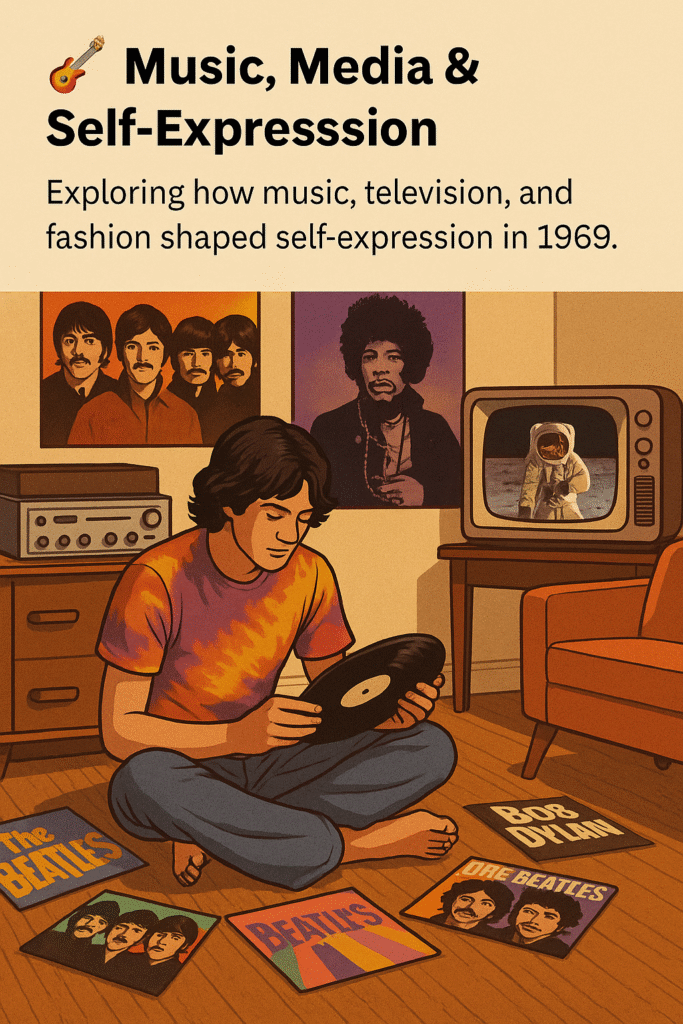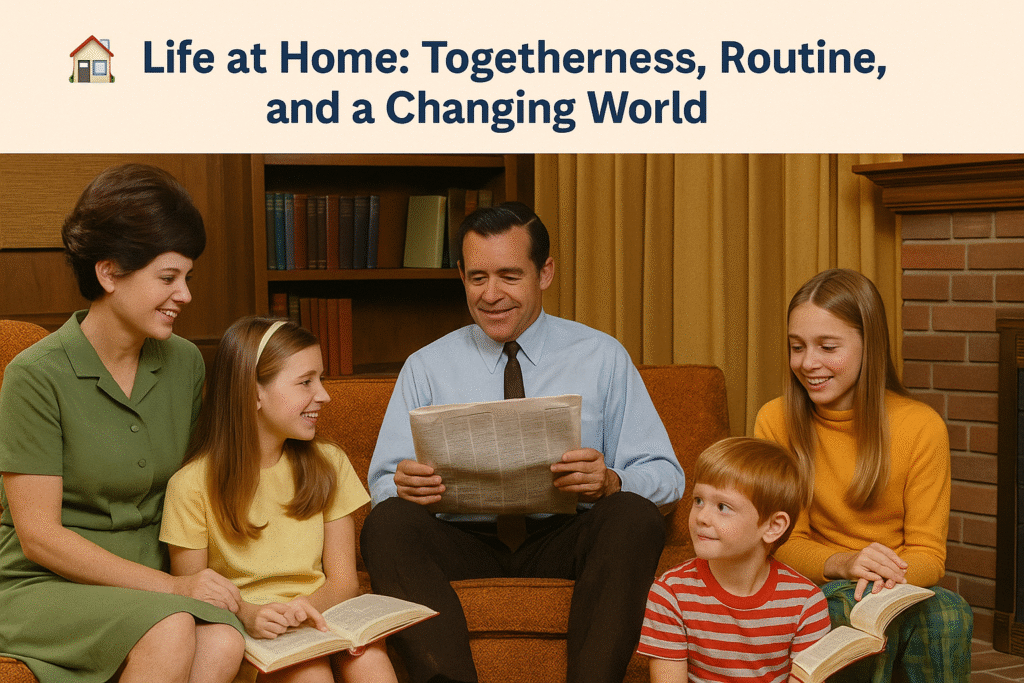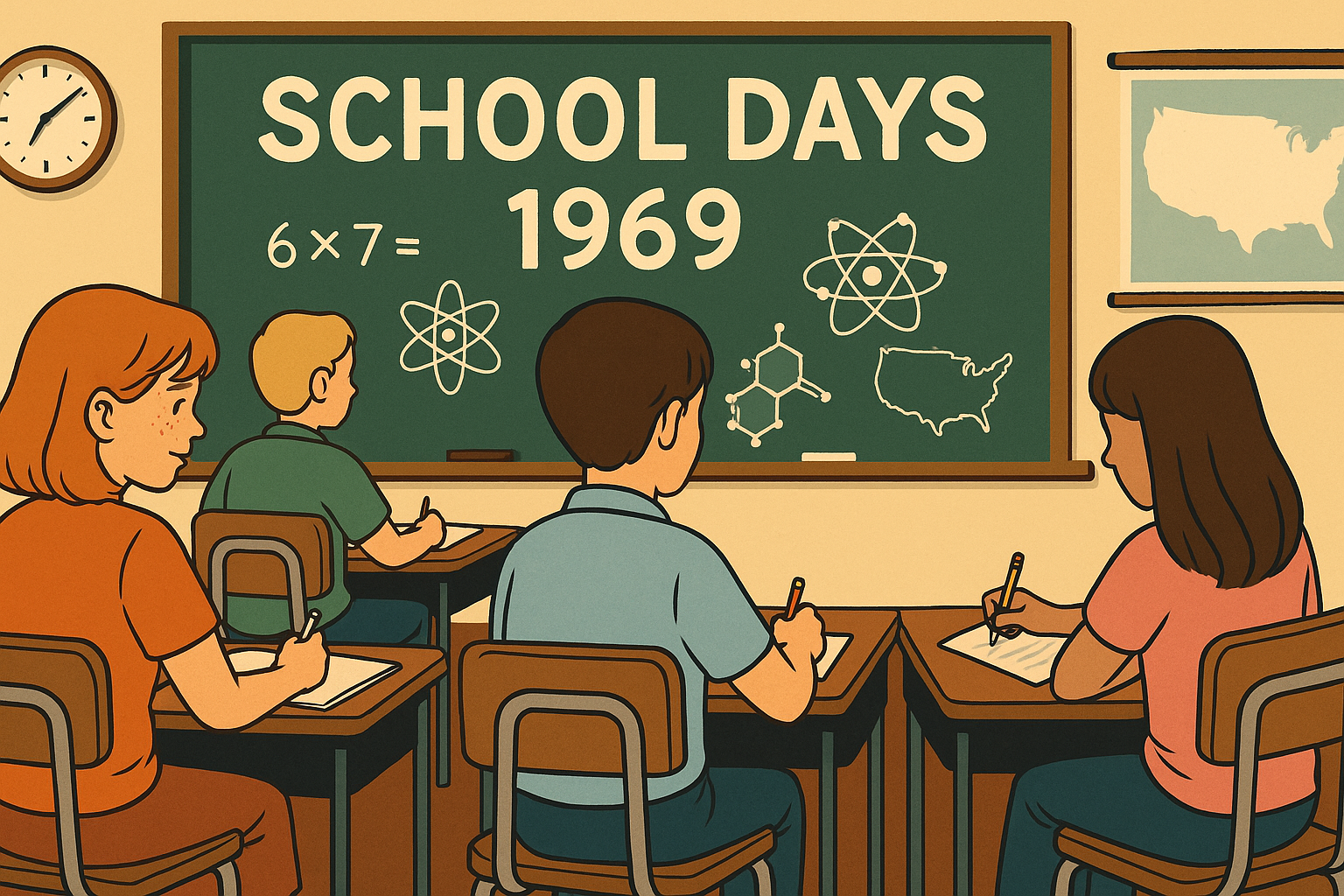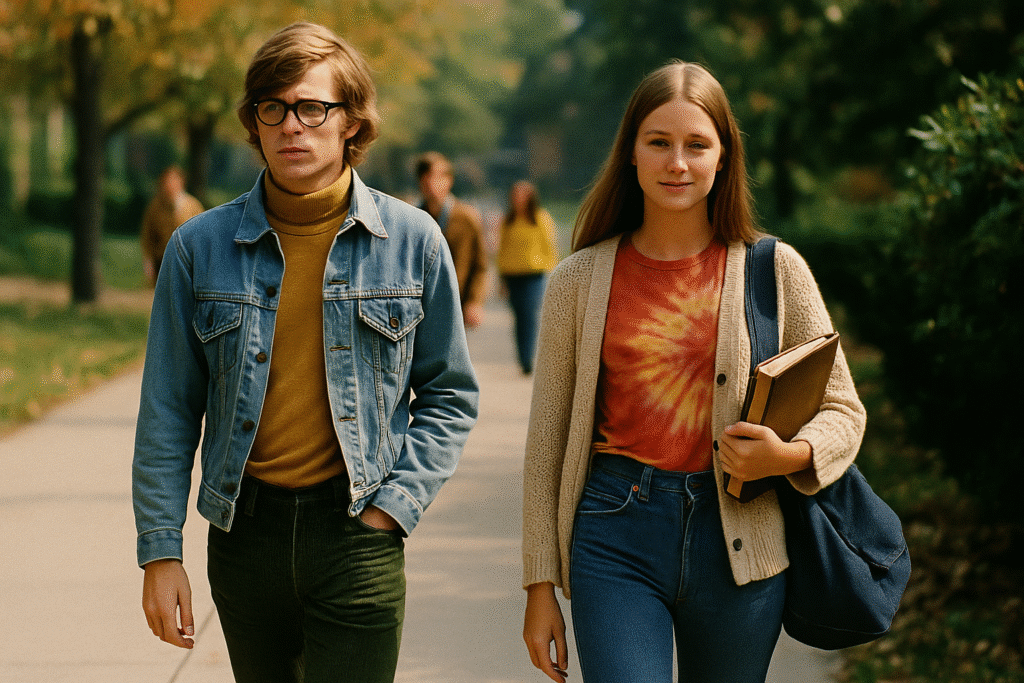📺 Music, Media & Self-Expression: Living Through the Culture
From Beatles records to Brady Bunch reruns, culture was both backdrop and lifeblood.

Growing up in 1969 was absolute magic for anyone who loved music. Rock ‘n’ Roll wasn’t just music, it was life! You couldn’t ignore the raw power of bands like Led Zeppelin and The Beatles as they shaped a whole era. Folks often hung around record stores, flipping through vinyls while chatting about the latest hits. It was all about connecting over shared rhythms.
Television also changed the way people entertained themselves. Shows like ‘The Brady Bunch’ and ‘Bewitched’ weren’t just diversions—they offered a glimpse into a different world and impacted family dynamics. These shows inspired conversations about the American family that lingered long after the TV was off. Those dinner discussions changed how families interacted.
And let’s not forget about fashion! Bell-bottoms and tie-dye shirts weren’t just a look, they were a statement. Anyone sporting these styles was part of the hippie movement, embracing peace and love as guiding principles. This flair wasn’t just about clothing; it was an expression of identity and beliefs.
So many defining events marked 1969, but the moon landing was a huge milestone. Watching Neil Armstrong take those iconic steps was surreal and made kids everywhere dream of exploring the unknown. And then, there was Woodstock—a festival that wasn’t just about music, but a celebration of freedom, unity, and the power of community.
As you look back at these cultural aspects, remember how they formed the backbone of everyday life, influencing choices, conversations, and future aspirations. The pulse of 1969 was felt in the songs, shows, and shared experiences that continue to echo in our lives today.
🏡 Life at Home: Togetherness, Routine, and a Changing World
Exploring the structure, technology, and rhythms of 1969’s family life.
In 1969, family life was all about togetherness, and it was pretty common to live in a bustling household. Families usually fell into the classic nuclear setup, with clearly defined roles—Dad worked hard to provide, and Mom often managed the home front. This setup shaped how homes rolled along day to day, and while it seemed traditional, it also brought a sense of comfort and routine.

Technology inside the home was revolutionizing daily life, even if it seems pretty basic looking back now. Color TVs were the big ticket, transforming black-and-white broadcasts into vivid adventures. Add in rotary dial telephones and you had the perfect setup for chatting with friends or catching up on the latest neighborhood news.
Time spent together often revolved around simple pleasures. Board games ruled the day, serving as the perfect excuse to gather around the kitchen table and have a bit of family fun. Outdoor play was just as popular—kids couldn’t resist a good game of catch or an afternoon on bicycles exploring neighborhoods.
Parental influence during this era was strong—it’s where values and discipline met freedom and growth. While parents held firm to imparting core beliefs and responsibilities, there was also this embrace of letting kids discover the world, becoming more involved in school or community activities.
These patterns and routines not only defined homes in 1969, they also carved out the paths that many kids followed into adulthood. The balance between structure and freedom offered lessons that felt simple but stuck with you, shaping how many would eventually raise their own families. Even now, these memories remind us of the strong foundations built on family bonds.
🏫 School Days: Lessons, Friendships, and Big Ideas
Inside the classroom and beyond, education was about much more than grades.
The classroom in 1969 was a unique place where ideas and personal interactions shaped young minds. Teachers played vital roles, often becoming mentors beyond textbooks. Student-Teacher relationships featured an air of respect and direct communication—sometimes with a healthy dose of chalkboard discipline.

Social life in schools revolved around the everyday drama of friendships, peer pressures, and the occasional end-of-day detention. Cliques formed, as they always do, letting kids find their crowd among sports enthusiasts, bookworms, and budding activists.
Extracurricular activities offered a great escape from the routine academic grind. Whether you hit the field, took part in drama, or unleashed creativity in art class, there was no shortage of ways to express yourself. These activities weren’t just about skill building—they were essential in carving out identity and sparking lifelong passions.
With the Vietnam War steadily looming in the backdrop, students weren’t insulated from the world outside the school. Awareness and conversations about war, peace, and activism were increasingly common, nudging teens to question their stance on bigger global issues. Kids grew up with open eyes, pondering how they’d contribute to society and where they stood on significant issues.
Looking back, school life in 1969 was a mix of lessons learned inside and outside the classroom. The education journey went beyond academics, encompassing all aspects of growing up and understanding the world. As those days faded into history, the experiences remained bright and sharp, with lessons that went on to inspire future generations.
🌱 Growing Pains: Freedom, Identity, and the Journey into Adulthood
Adolescence in 1969 was equal parts tradition and transformation.
Navigating adolescence in 1969 was about juggling tradition and newfound freedoms. Family expectations set certain paths, but each day felt like a new opportunity to carve out a unique identity. It was all about finding that balance between what was comfortable and what was excitingly unknown.

Milestones marked the journey—graduations were celebrated with pride, signaling the start of adulthood responsibilities. Landing that first job wasn’t just about earning— it was a rite of passage, a chance to start saving for dreams big and small. And driving? A true ticket to freedom! The open road was an invitation to explore, daydream, and discover.
Cultural exploration was limited only by imagination. Music, art, and personal hobbies all played parts in creating identities. Many found themselves scribbling lyrics, picking up paintbrushes, or strumming guitars, surrounded by peers who shared a thirst for creativity and self-expression.
Aspirations for the future varied. Some envisioned college, others imagined settling into careers, and many dreamed of possibilities that seemed endless. Societal expectations nudged them along, yet there was something empowering about stepping into adulthood with optimism. The excitement of possibility brewed with every choice they made.
Growing up in 1969 was a journey sculpted by cultural shifts, family values, and personal aspirations. These formative experiences became the seeds of change, growing into narratives that shaped not just individuals, but the communities they built in their adult lives.
✨ What Are *Your* Memories of 1969?
Did you grow up in the era of bell-bottoms, Brady Bunch reruns, and moonwalk dreams? We’d love to hear your personal recollections of life in 1969. Whether it’s your favorite song, a family memory, or your first brush with independence, drop a comment below and share your story. Let’s keep the spirit of ’69 alive together! 🌻🎶


2 thoughts on “🎸 Growing Up in 1969: A Personal Recollection of Everyday Magic”
Reading this post felt like stepping into a time capsule! I loved how you painted such a vivid picture of daily life, from music and fashion to family routines and school dynamics. It’s incredible how even the simplest things, like board games or TV shows, shaped strong family bonds and cultural values. It made me reflect on how today’s fast-paced lifestyle compares. Do you think any part of 1969’s slower, more connected living could make a comeback in our digital age?
Thank you so much for your kind words! I love that the post felt like a time capsule to you—that’s exactly what I hoped to capture. There really was something special about the rhythm of life back in 1969: fewer distractions, slower evenings, and more face-to-face connection, whether around a board game or a TV set.
You bring up such an important point—today’s fast-paced, screen-saturated world sometimes feels miles away from that kind of everyday intimacy. But I do believe parts of that slower, more connected living can make a comeback. We’re seeing a growing appreciation for analog activities—vinyl records, handwritten letters, even game nights—and more people carving out “tech-free” time with family or in nature. It’s like the old spirit of togetherness is gently resurfacing.
Maybe the best parts of 1969 aren’t gone—they’re just waiting for us to slow down and rediscover them. ✨
Thanks again for sharing your reflections—it’s always wonderful to connect over shared memories and questions that matter!